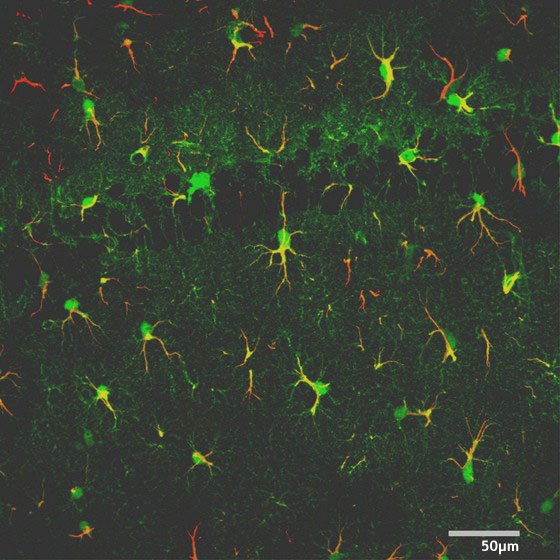Mar. 27, 2009 Research Highlight Biology
Reciprocal communication
Brain cells called astrocytes secrete the S100B protein to modulate the network activity of neurons
 Figure 1: An S100B positive cell (green) labeled with an astrocyte-specific protein (red). S100B protein is secreted by astrocytes to modulate neuronal network activity.
Figure 1: An S100B positive cell (green) labeled with an astrocyte-specific protein (red). S100B protein is secreted by astrocytes to modulate neuronal network activity.
Star-shaped brain cells known as astrocytes maintain the extracellular environment of nearby neurons. But, according to recent research, they also play an active role in neuronal activity by secreting small molecules, such as the excitatory neurotransmitter glutamate.
S100B is a calcium-binding protein found in the brain and expressed by astrocytes. In previous work, Hajime Hirase and his colleagues at the RIKEN Brain Science Institute in Wako showed that mice lacking S100B have reduced gamma oscillations, which are a type of brain wave. These oscillations represent neuronal network activity that is involved in learning and memory.
Now, as reported in a recent issue of The Journal of Neuroscience 1, these researchers and their collaborators at Kanazawa University have shown that S100B is also secreted by astrocytes (Fig. 1). S100B then acts on neurons via its receptor, RAGE (receptor for advanced glycation end products), to modulate gamma oscillations, which represent neuronal network activity in the brain.
Kainate, an activator of a class of glutamate receptors, induces gamma oscillations when it is injected into mice. Hirase and colleagues demonstrated that infusing S100B protein into mice lacking S100B expression could restore the gamma oscillations induced by kainate. Because the S100B protein was not taken up into the cells, it seemed to be acting extracellularly by binding to a receptor on the outside of the cells in the brain to affect neuronal network activity.
The amplitude of gamma oscillations was reduced in mice that lacked the gene for RAGE, or in mice where RAGE was blocked by a specific antibody against it. Therefore, extracellular S100B affects gamma oscillations by binding to RAGE on the surface of brain cells.
Hirase and colleagues also determined that neuronal activity plays a key role in S100B release from astrocytes, because inhibition of neuronal activity reduces its release. In addition, secretion of S100B from astrocytes could be induced by application of the neurotransmitter glutamate onto astrocytes in culture. The glutamate receptor mGluR3 (metabotropic glutamate receptor 3) is required for S100B release: administering an mGluR3 blocker onto mouse brain slices reduced secretion of S100B, and administering an mGluR3 activator induced its secretion.
S100B is a considerably larger molecule than the previously identified astrocyte signaling molecules. Therefore, it is possible that astrocytes may secrete additional proteins to modulate neuronal network activity in the brain.
As the next step in their research, Hirase says that he and his colleagues plan to determine “how neuron–glia communication is important for learning and memory”.
References
- 1. Sakatani, S., Seto-Ohshima, A., Shinohara, Y., Yamamoto, Y., Yamamoto, H., Itohara, S. & Hirase, H. Neural-activity-dependent release of S100B from astrocytes enhances kainite-induced gamma oscillations in vivo. The Journal of Neuroscience 28, 10928–10936 (2008). doi: 10.1523/JNEUROSCI.3693-08.2008
